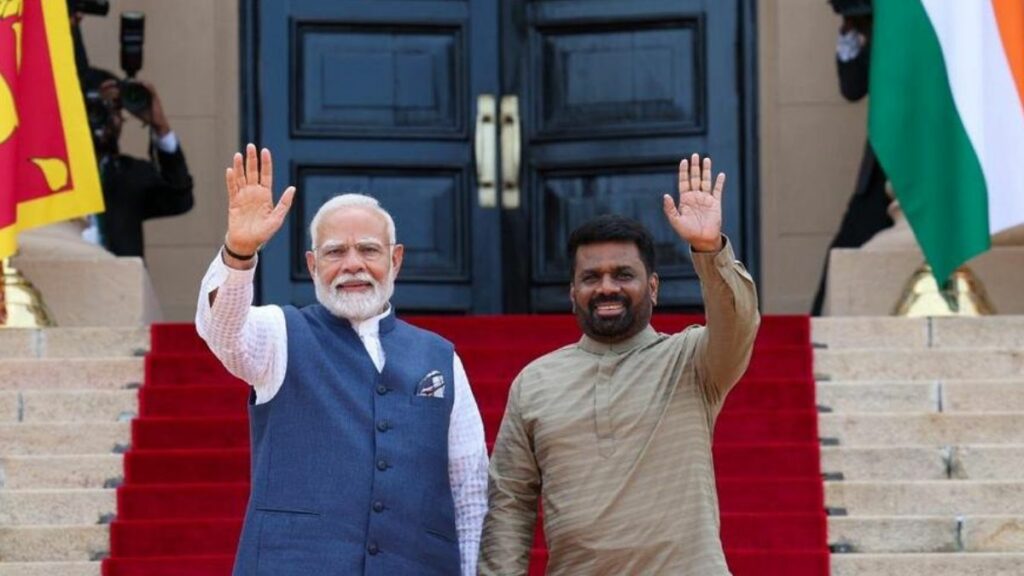
- During this important visit, several MOUs and agreements were signed, and one of the key MOUs was the Trincomalee Energy Hub Development to be jointly developed by India and UAE.
- President Anura desires to renegotiate the existing debt agreement with India, as he believes the terms signed during former President Ranil’s tenure are not favourable to Sri Lanka.
- The Sri Lankan President has committed that his country wouldn’t be used for any anti-India activities, and as a goodwill gesture, his government decided to free 12 Indian fishermen.
- India’s strong commitment to Sri Lanka is important not only for strengthening bilateral ties but also for countering Chinese influence in the region.
Prime Minister Modi was on a two-day state visit to Sri Lanka. This was the first visit of Prime Minister Modi since the coming of new President Anura Dissanayake to Sri Lanka. On the visit of Prime Minister Modi, Sri Lanka offered a great and very rare welcome, showing growing ties between the two countries. This visit was important as many historic agreements were signed between the two countries. This was also the reciprocal visit by Prime Minister Modi after the Sri Lankan President visited India in December last year.
Pathbreaking Agreements and MOUs
During this important visit, several MOUs and agreements were signed, and one of the key MOUs was the Trincomalee Energy Hub Development to be jointly developed by India and UAE. A solar power initiative was launched as Prime Minister Modi inaugurated the construction of a 120-megawatt solar power plant in Sri Lanka’s eastern region.
In addition, important agreements were signed on defence cooperation. For the first time, India and Sri Lanka agreed to strengthen their defence capabilities. This agreement includes provisions for India to supply arms and enhance defence collaborations. Along with this, infrastructure projects have also been signed, including electricity grid connectivity and a multi-product petroleum pipeline. Additional grant assistance will be provided for rehabilitating the Maho-Anuradhapura railway station and developing Kankesanthurai Port by India.
In the field of education, a new education initiative will start next year, under which 200 students from the Jaffna and Eastern provinces will receive monthly scholarships, and 1,500 civil servants will be trained in India over the next five years.
This visit was also important because the Sri Lankan President conferred Prime Minister Modi with the Sri Lanka Mitra Vibhushana, the highest honour for any foreign leader. The Sri Lankan President also committed that Sri Lanka wouldn’t be used for any anti-India activities, and as a goodwill gesture, the Sri Lankan government decided to free 12 captured Indian fishermen.
Srengthening Bilateral Ties and Countering Threats
This visit of Prime Minister Modi has been particularly important to Sri Lanka because it comes at a time when Sri Lanka is going through an economic transition, trying to come out from the shock it experienced in 2022 when it went into a complete economic disaster. Since then, Sri Lanka has adopted a pragmatic approach. We saw this during the tenure of Ranil Wickremesinghe, who took a sensible approach toward India and avoided repeating the mistakes made by Mahinda Rajapaksa, who had completely tilted towards China. That approach led Sri Lanka into a Chinese debt trap, which was one of the reasons for the country’s economic downfall.
Since then, Sri Lanka has somewhat recovered. However, in September last year, concerns resurfaced when the National People’s Power (NPP), a communist coalition headed by Anura Dissanayake, was elected to power. There was a concern in Indian diplomatic circles that the coming of a communist regime in Sri Lanka might not go well for India due to its ideological proximity with the Chinese Communist Party. But within five months of President Anura’s tenure, those concerns seem to have been addressed.
India was the first country President Anura visited after becoming President. This was a great gesture by the Sri Lankan leadership. With Prime Minister Modi now visiting Sri Lanka and signing several important agreements, including the first-of-its-kind defence agreement, the earlier concerns regarding Sri Lanka’s approach have been largely silenced.
At present, the whole of South Asia is going through instability. What happened in Bangladesh has also been a matter of concern for India, as Bangladesh has been one of India’s key allies in the region. With the unexpected change of guard there, questions arose regarding India’s influence in South Asia. That is why Prime Minister Modi’s Sri Lanka visit becomes important, as Sri Lanka now lies at the centre of India’s foreign policy outreach in South Asia.
India’s strong commitment to Sri Lanka is important not only for strengthening bilateral ties but also for countering Chinese influence in the region. China’s Belt and Road Initiative has already seen them take over the Hambantota Port, and Chinese attempts to use Sri Lanka as a maritime base to monitor India have been visible over the years, especially with repeated visits of Chinese surveillance ships Yuan Wang 5.
Now, President Anura’s confirmation that Sri Lanka won’t be used for any anti-India activities marks an important development. Sri Lanka has understood how India helped during its economic disaster by offering the first major economic relief worth billions of dollars. It was also India’s diplomatic pressure that forced China to restructure its debt agreement with Sri Lanka—something seen as a major positive for India-Sri Lanka ties.
Identifying and Resolving Differences
However, there are still some differences. One of them is President Anura’s desire to renegotiate the existing debt agreement with India, as he believes the terms signed during former President Ranil’s time are not favourable to Sri Lanka. But considering the positive platform President Anura has managed to create, he seems to have laid the groundwork to open talks with India on renegotiation.
Another major difference that exists between India and Sri Lanka is about fishing grounds. India uses both traditional and mechanized methods of fishing, including trawlers and bottom trawling, whereas Sri Lanka uses artisanal fishing, which is a traditional and low-cost method of fishing.
Since India is a peninsular country and Sri Lanka is a complete island nation, both countries have tremendous maritime fishing potential. For Sri Lanka, fishing contributes to almost 2% of the GDP, whereas for India, it contributes around 1%. The difference becomes evident in the Palk Strait region, where Indian trawlers, mainly from Tamil Nadu, come very close to Sri Lankan waters. This leads to frequent arrests and diplomatic tensions. The Indian side does not do this intentionally, but due to the lack of proper marking and demarcation of the maritime boundary, there are frequent violations by both India and Sri Lanka. In return, Sri Lanka always accuses Indian fishermen of depleting fish stocks and damaging marine habitats. This has been a historical issue.
During the Indira Gandhi administration, India attempted to resolve the issue by offering the Katchatheevu Island to Sri Lanka in 1974. However, rather than resolving the matter, this added fuel to the fire. The island is rich in marine resources and now gives a direct strategic advantage to Sri Lanka. Since it is just 34 kilometers from Rameswaram, Indian fishermen often visit the area and sometimes cross into Sri Lankan waters, which continues to create diplomatic tensions between the two countries. The Indian side has always maintained that the issue should be solved diplomatically. As a positive gesture, President Anura recently freed 12 Indian fishermen who were in Sri Lankan custody, indicating that even the Sri Lankan government is determined to resolve the differences with India.
Conclusion
The visit of Prime Minister Modi is an important indication that India and Sri Lanka are on the same page and share mutual respect and strategic interest. At a time when South Asia is going through instability, India-Sri Lanka bilateral relations are critical for creating a unified and stable regional environment.
References:
- https://www.ndtv.com/india-news/pm-modi-in-sri-lanka-lankas-big-gesture-for-pm-modi-a-grand-welcome-that-sets-new-precedent-8091848
- https://www.thehindu.com/news/international/pm-modis-visit-reinforces-sri-lankas-important-role-in-indias-neighbourhood-first-policy-says-dissanayakes-office/article69419807.ece
- https://www.indiatoday.in/india/story/pm-modi-sri-lanka-trip-colombo-president-dissanayake-talks-agreements-mous-projects-signed-2704718-2025-04-06
- https://thefederal.com/category/news/katchatheevu-pm-modi-sri-lanka-fishing-detained-fishermen-palk-strait-180140
Aayush Pal is a freelance writer on contemporary geopolitical developments. The views expressed in his work are entirely his own.
